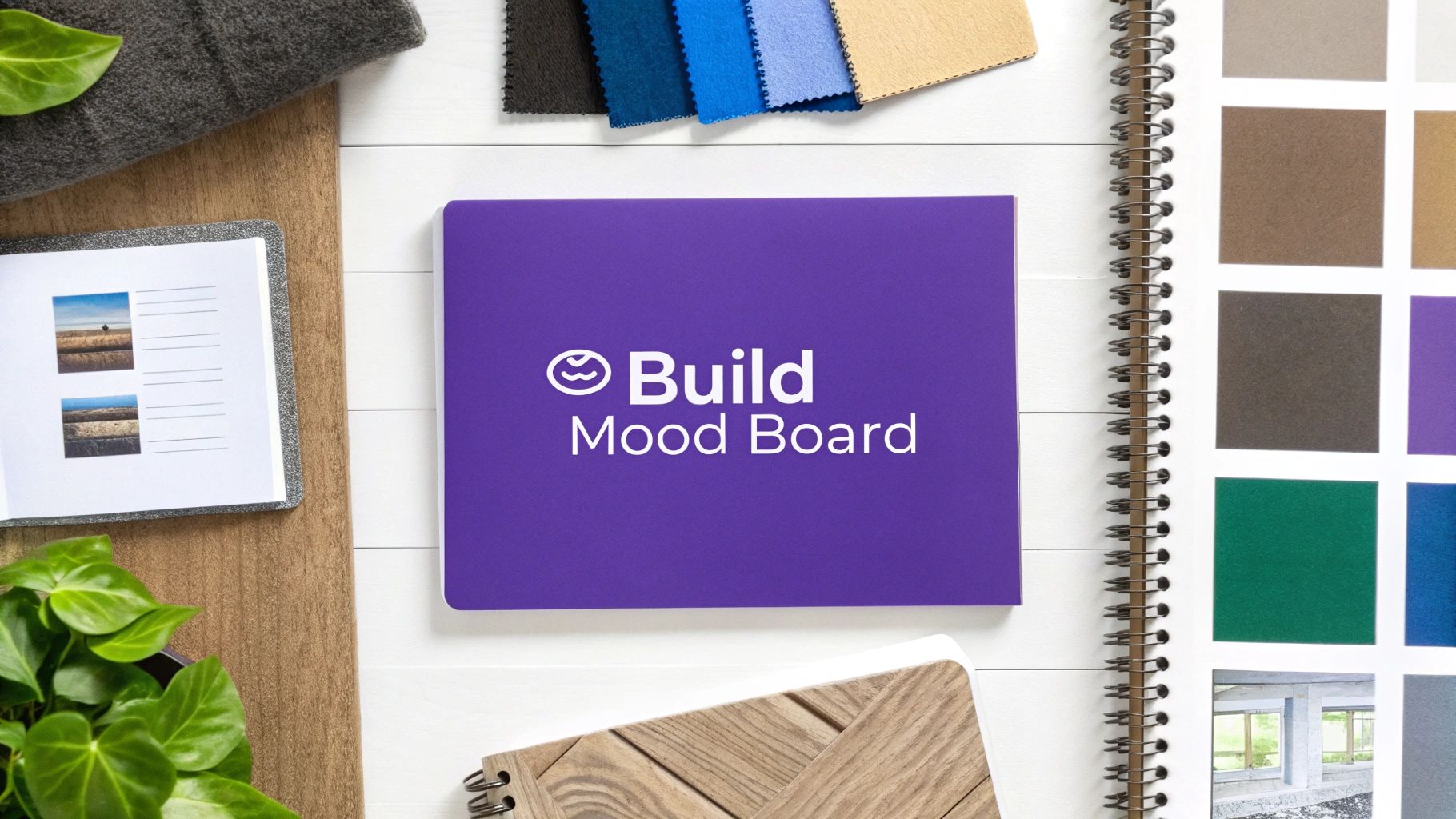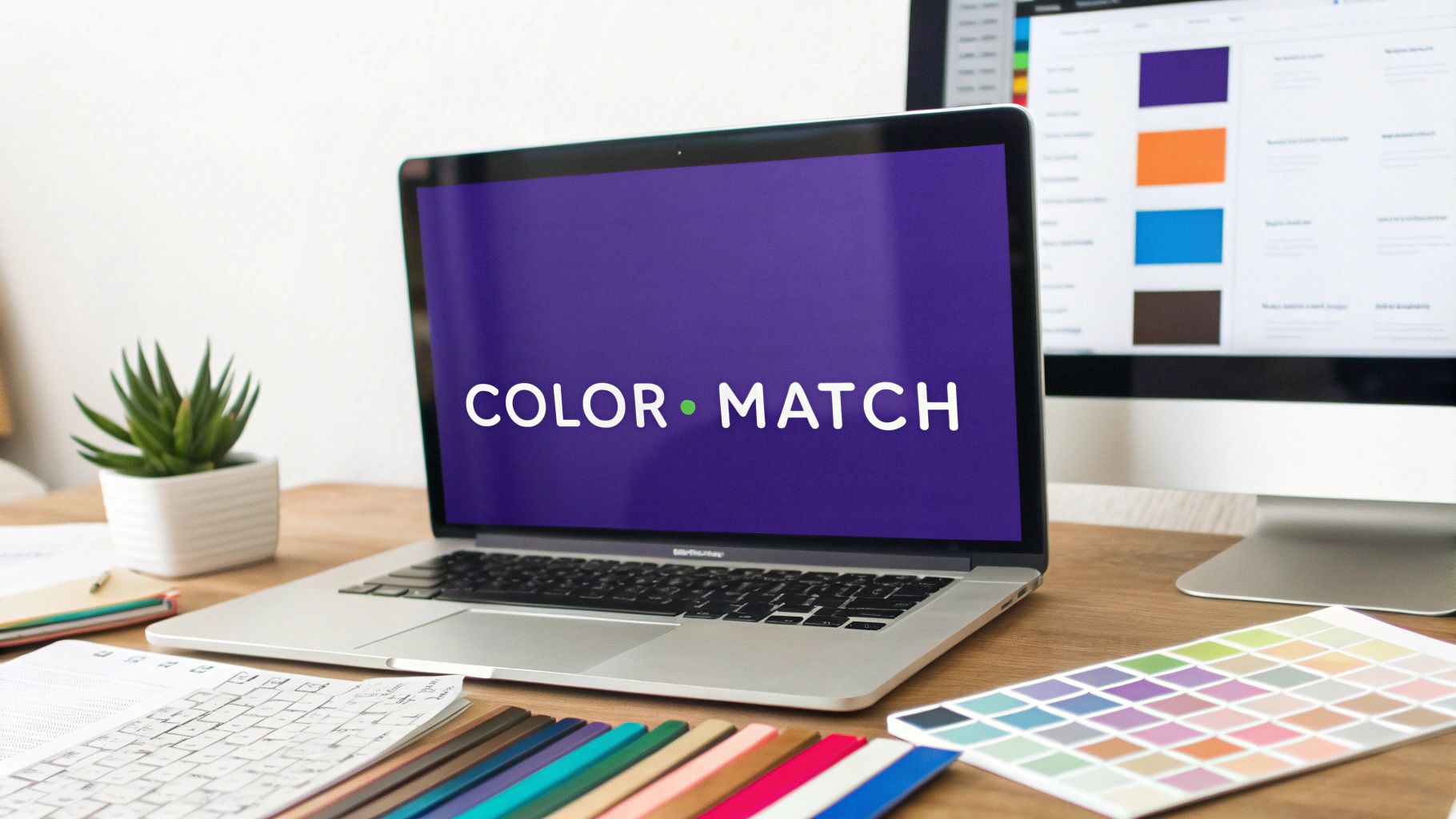
How to Determine Your Color Palette: Expert Tips
By Emma Johnson - 8/8/2025
The Science Behind Effective Color Selection

Selecting the right color palette is a blend of art and science. It's about more than just choosing colors that look good together. It requires creative intuition combined with an understanding of color interaction and how colors influence perception. Skilled designers understand this, using color theory to craft palettes that deeply connect with their target audience. This involves understanding both the aesthetics and the psychology of color.
Understanding Color Harmonies
Color harmonies are fundamental to color theory. These are color combinations that create visual balance and appeal. They offer a solid foundation for palette creation, ensuring colors work together harmoniously.
- Complementary: These colors sit opposite each other on the color wheel (e.g., blue and orange). They create a vibrant, high-contrast effect.
- Analogous: These colors are adjacent on the color wheel (e.g., green, blue-green, and blue). They evoke a sense of calm and harmony.
- Triadic: These are three colors evenly spaced on the color wheel (e.g., red, yellow, and blue). They offer a balanced and visually stimulating combination.
While these harmonies offer a starting point, the sheer number of potential color combinations can feel overwhelming. A simple three-color palette, for instance, has roughly 4.7 sextillion possible combinations. This vast range highlights the complexity involved in picking the right colors. Balancing aesthetics, accessibility, and purpose is critical. Tools like the International Commission on Illumination (CIE)'s ΔE* measurement can help quantify perceptual color differences, making the selection process more manageable. For a deeper dive into this topic, explore How to pick the least wrong colors.
The Psychology of Color
The psychological impact of color is essential for effective palette selection. Blue, for example, often represents trust and stability, making it a common choice for corporate branding. Green connects with nature and tranquility, while red can signify excitement and energy. By understanding these associations, you can select colors that align with the desired emotional response from your audience. For further exploration, A Comprehensive Guide to Understanding Skin Undertone might be of interest.
Practical Application of Color Theory
By combining color harmonies with color psychology, you can create palettes that are both visually attractive and strategically effective. This allows you to use color's power to communicate your brand message, improve user experience, and achieve your design goals. Resources like AI Color Analysis can be incredibly helpful in identifying the ideal colors that complement natural features and resonate with personal style.
Aligning Your Palette With Purpose and Audience
Every exceptional color palette starts with a defined purpose. What do you want your colors to do? Are you striving for brand differentiation, a smoother user experience, or perhaps a specific emotional response? Successful designers identify these goals early, building their palette around strategic objectives. This means going beyond simply selecting visually appealing colors and considering their functional role in the overall design.
Understanding Your Target Audience
Analyzing your target audience is essential when determining your color palette. Think about the cultural associations your target audience might have with certain colors. For example, red can symbolize good luck in some cultures, while in others, it represents mourning. Generational preferences also play a significant role. Younger audiences may be drawn to bolder, more vibrant colors, while older demographics may favor more subdued palettes. Industry expectations should also be considered. A tech startup, for instance, might embrace bright, modern colors, whereas a law firm might choose a more traditional, conservative palette.
Conducting Competitive Color Audits
A competitive color audit analyzes the color palettes of your competitors. This process can uncover opportunities to differentiate your brand. If every competitor uses blue, selecting a different primary color can make your brand instantly recognizable. However, maintaining balance is important. While differentiation is vital, your palette should still align with industry conventions enough to maintain credibility. You might find this resource helpful: How to master the perfect color palette.
Creating Intentional Color Choices
Intentional color choices resonate with your users. This requires understanding the psychology of color. Green, for instance, is often associated with nature and tranquility, while purple can evoke feelings of luxury and creativity. By carefully selecting colors based on their psychological impact, you can influence user perceptions and behaviors. This goes beyond simply following trends; it’s about forging a lasting connection with your audience through deliberate color choices. Learn more in our article on How to Master AI for Color Analysis. This thoughtful process allows you to create palettes that are not only visually attractive but also communicate effectively and achieve your design goals. Remember, the key to an effective color palette lies in balancing aesthetics with strategic goals and a deep understanding of your audience.
Mastering Different Palette Types for Maximum Impact

Not all color palettes are created equal. Understanding the nuances of different palette types is crucial for maximizing their impact, whether you're designing a website or establishing a brand identity. This requires strategic thinking about how colors work in different contexts. Let's explore some key palette types and how they're applied.
Brand Identity Palettes
A brand identity palette is the core visual language of a brand. It ensures consistency across all platforms, from websites and marketing collateral to product packaging. These palettes typically consist of a primary color, secondary colors, and neutral accents. This cohesive system builds brand recognition and reinforces the brand message.
- Primary Color: The dominant color, representing core brand values.
- Secondary Colors: Supporting colors that complement the primary color and create depth.
- Neutral Accents: Background and text colors that offer balance and ensure readability.
These core components work together to create a unified brand experience.
Functional Palettes for User Interfaces
Functional palettes, unlike brand identity palettes, focus on guiding user behavior in digital interfaces. Usability and accessibility are key, using color to highlight important elements, provide feedback, and create visual hierarchy. For example, a call-to-action might use a contrasting color to grab attention and encourage clicks. This strategic use of color enhances the user experience and improves interface effectiveness.
Data Visualization Palettes
Data visualization palettes effectively represent data. Choosing the right palette depends on the type of data being presented. Three main types are: qualitative, sequential, and diverging. Qualitative palettes suit categorical data, using distinct colors for each category. It's best to limit these to ten colors or fewer to avoid confusion. For example, a chart showing workforce demographics might use different colors for various ethnicities. For more detailed information, refer to Atlassian's guide on choosing colors for data visualization. Sequential and diverging palettes are used for ordered data and data deviating from a central point, respectively.
To understand the different applications of color palettes, let's examine the following table:
Types of Color Palettes and Their Applications
This table compares different color palette types, outlining their characteristics, ideal use cases, and potential limitations.
| Palette Type | Best Used For | Ideal Number of Colors | Key Characteristics | Limitations |
|---|---|---|---|---|
| Monochromatic | Creating a sense of unity and simplicity | 1 base color + tints and shades | Clean, elegant, easy to coordinate | Can lack visual interest if not used creatively |
| Analogous | Designs that need a natural, harmonious feel | 2-3 colors next to each other on the color wheel | Pleasing to the eye, creates a sense of flow | Can be challenging to create contrast |
| Complementary | Creating high contrast and visual interest | 2 colors opposite each other on the color wheel | Vibrant, energetic, draws attention | Can be overwhelming if not balanced carefully |
| Triadic | Designs that need a balanced and vibrant feel | 3 colors evenly spaced on the color wheel | Stimulating, offers a good balance of contrast | Can be challenging to harmonize if colors are too saturated |
| Tetradic (Rectangular) | Rich and complex designs | 4 colors forming a rectangle on the color wheel | Diverse, allows for a variety of moods | Requires careful planning to avoid clashing colors |
The table summarizes key differences and similarities between the various palette types, helping to guide your color choices depending on your specific needs.
Optimal Color Counts and Visual Hierarchy
A palette's color count impacts its effectiveness. Brand palettes might use fewer colors to maintain focus, while data visualization might need a broader range. Establishing a clear visual hierarchy is essential for any palette. This uses color contrast and saturation to differentiate elements and direct the viewer's eye. Lighter tints might represent less vital information, while bolder shades highlight key data points.
Maintaining Flexibility and Ensuring Recognition
A good palette balances flexibility and recognition. It adapts across different applications, from print to digital, while staying distinct and recognizable. This often involves a system with variations in tints, shades, and tones. This ensures consistent brand recognition across all platforms. Mastering these palette types helps you make strategic color choices that are both aesthetically pleasing and effective.
Essential Tools and Methods That Actually Work

Determining your color palette is a crucial design decision. It's not simply about personal preferences, but about understanding the interplay of colors, their impact on perception, and their strategic use to achieve design objectives. Thankfully, there are various tools and techniques to guide you through this process.
Leveraging Digital Tools
Digital tools like Adobe Color Adobe Color and Coolors Coolors offer advanced functionalities beyond basic color selection. They allow you to explore color harmonies, generate palettes from images, and even check for accessibility compliance. For instance, Adobe Color lets you adjust color values using different color models like RGB and CMYK. Coolors allows you to lock specific colors and generate variations. Many users are unaware of these advanced features, missing out on powerful palette creation possibilities.
These tools streamline the color selection process. They help designers create palettes that are aesthetically pleasing and technically sound.
Drawing Inspiration From the Real World
Many successful designers find inspiration in nature, art, photography, and cultural elements. This approach results in authentic palettes that resonate with viewers. It might involve extracting colors from a landscape photograph or analyzing the color scheme of a painting. By transforming real-world inspiration into cohesive color systems, designers create palettes that feel unique and relatable. For further exploration on color analysis, check out this helpful resource: How to master the art of color analysis for eye and hair color.
Real-world inspiration adds depth and meaning to color palettes, making them more engaging and memorable.
Building From a Core Color vs. Working Backward
There are two main approaches to building a color palette: starting with a core color and expanding outwards, or working backward from multiple reference points. The core color approach involves selecting a dominant color representing the overall mood or theme, then choosing supporting colors that complement it. The backward approach might begin with colors from an image or object, then refining them into a usable palette. Each method has its merits, and the ideal choice depends on the project’s needs.
Thinking about color palettes in terms of probability can be helpful. With ten equally likely combinations, each has a 10% chance of being chosen. This statistical approach helps in systematically evaluating and optimizing palettes. Learn more about the intersection of probability and color palettes%20Probability%20and%20Statistics.pdf).
Testing Color Combinations in Different Contexts
Testing color combinations in different contexts, lighting conditions, and for accessibility is crucial. A palette that looks appealing in isolation might not work well in a real-world application. Colors can appear differently on screen versus print, and some combinations can create accessibility challenges for users with visual impairments.
Thorough testing ensures your palette is effective and inclusive across various mediums and audiences. This meticulous process helps avoid issues with color contrast, readability, and overall visual impact. Testing allows you to refine your palette for optimal performance across different design scenarios.
Testing Your Palette for Real-World Performance

Developing a color palette is just the first step. Rigorous testing is what elevates a good palette to a great one. This crucial stage goes beyond subjective preferences and focuses on objective evaluation, ensuring your colors perform well in practical applications. It requires a systematic approach using various testing methods to refine your choices and ensure they meet both aesthetic and strategic goals.
Accessibility Contrast Checks
One of the most critical tests is checking for accessibility. This means ensuring enough contrast between foreground and background colors, making your design usable for people with visual impairments. The WCAG (Web Content Accessibility Guidelines) offer specific contrast ratio standards, ensuring text and other elements are easily visible. Tools like contrast checkers help verify if your palette meets these crucial requirements. Addressing accessibility early is far more efficient than making corrections later.
User Testing Protocols
Understanding how colors influence user behavior is key. User testing offers invaluable insights into how your audience perceives and interacts with your palette. This can include A/B testing different color variations of a website or app to see which performs best in terms of engagement or conversions.
For example, testing various button colors can reveal which one leads to more clicks. This data-driven process helps quantify the impact of color choices on user actions. Qualitative user feedback also reveals emotional responses and color associations. This information is essential for refining your palette to effectively communicate your message. User testing identifies potential problems early, saving time and resources.
A/B Testing and Performance Quantification
A/B testing quantifies palette performance by comparing design versions with different color schemes. This identifies the most effective palette for specific objectives, like increasing conversions or improving user engagement. For example, testing color combinations for a call-to-action button shows which version gets more clicks and, ultimately, conversions. This data-driven approach removes the guesswork from color selection.
Real-world applications often uncover unforeseen issues. Colors may clash in different lighting, or some combinations may not translate well across various media. A digital palette might look different when printed. The Afrobarometer surveys, while not directly related to creating color palettes, offer a relevant case study on consistent data presentation. They demonstrate how standardized questionnaires and visualizations, including a thoughtful color palette, ensure clarity across different contexts. You can explore this topic further here.
Gathering Stakeholder Feedback
Gathering stakeholder feedback ensures alignment and buy-in. Creating a framework for collecting feedback while preserving design integrity is crucial. This could involve showcasing different palette options and explaining the logic behind each. Clear communication and collaboration are essential for ensuring the final palette satisfies aesthetic and strategic goals. This cooperative process results in a more refined and impactful color palette. By using these testing methods, you can elevate a good color palette to a truly great one, optimizing its effectiveness for any application. The goal is to create a palette that not only looks visually appealing but also performs well, fulfilling design goals and user needs.
Implementing Your Palette With Precision and Flexibility
A well-chosen color palette forms the bedrock of impactful design. However, even the most striking palette can underperform without careful and adaptable implementation. This means transforming your hand-picked colors into a holistic system, ensuring visual consistency across every application. It's about crafting a unified visual language that effectively communicates your brand or project’s message.
Assigning Functional Roles and Proportions
Every color within your palette should serve a distinct purpose. This might involve a primary brand identifier, secondary supporting accents, and neutral background hues. Imagine constructing a house: the primary color is the foundation, secondary colors form the walls and roof, and accents act as the furniture and decor.
Defining proportion guidelines creates visual balance. As an example, the 60-30-10 rule could allocate 60% of the design to the primary color, 30% to secondary colors, and 10% for accent colors. This promotes visual harmony and keeps any single color from dominating.
Extending Your Core Palette: Tints, Shades, and Tones
Even a concise core palette can be expanded with tints, shades, and tones. A tint results from mixing a color with white, a shade is created by mixing a color with black, and a tone comes from mixing a color with gray. These variations empower you to tackle a variety of design requirements while upholding a consistent look and feel.
You could, for example, use a lighter tint of your primary color for backgrounds and a darker shade for text. This ensures readability and creates visual appeal. The thoughtful application of tints, shades, and tones injects depth and dimension into your work.
Documenting Your Color Palette
Comprehensive documentation avoids confusion and guarantees consistency. Standardized notation across various color spaces—HEX, RGB, CMYK, and Pantone—is essential for collaborating with teams, clients, and vendors. Think of these as different languages for representing the same color. A style guide with practical examples further clarifies usage and prevents inconsistencies. Visual examples illustrating color application in different situations offer added benefit.
This detailed documentation acts as a central reference for everyone involved, guaranteeing the color palette’s correct usage across all applications.
Building a Color Palette Implementation Checklist
A checklist helps streamline the implementation process across various mediums. The table below outlines implementation steps for digital, print, and environmental applications, emphasizing each step’s importance.
To make the implementation process smoother, it’s helpful to create a checklist that you can reference. This checklist can be organized into a table format, outlining the necessary steps for different applications.
Color Palette Implementation Checklist
| Implementation Step | Digital Application | Print Application | Environmental Application | Importance Level |
|---|---|---|---|---|
| Define primary, secondary, and accent colors | Website, App UI | Brochures, Business Cards | Signage, Interior Design | High |
| Specify color values (HEX, RGB, CMYK, Pantone) | Digital assets | Print files | Paint specifications | High |
| Create usage guidelines with examples | Style guide | Printed samples | Material boards | Medium |
| Conduct accessibility contrast checks | WCAG compliance | Print contrast analysis | Lighting considerations | High |
| Test color rendering across different devices and materials | Screen calibration, browser testing | Press checks | On-site color evaluation | Medium |
| Document and communicate changes to stakeholders | Version control | Revision notes | Update specifications | High |
This checklist ensures that your color palette transitions seamlessly across different platforms and maintains its intended effect. Following these guidelines guarantees that your palette contributes to a cohesive and effective design system.
Take your style to the next level with a professional analysis
You already know the theory. Now discover exactly which colors and styles enhance your personal image.
Loading...
Complete PDF report in less than 5 minutes
Your color season and personalized palette
Specific makeup and clothing recommendations
Based on professional color analysis
One-time investment:
One-time payment, no subscriptions. Instant access.